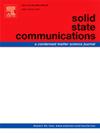Contrasting structural stability and phase transition of α- and β-Ag2WO4 under pressure
IF 2.1
4区 物理与天体物理
Q3 PHYSICS, CONDENSED MATTER
引用次数: 0
Abstract
Ag2WO4 has attracted wide interest due to its excellent visible light photocatalysis. Besides special property, Ag2WO4 exhibits rich polymorphism and crystallizes in three polymorphs. In the present work, orthorhombic α-Ag2WO4 and hexagonal β-Ag2WO4 were successfully synthesized. Structural stability and structural evolution were in situ investigated for two types Ag2WO4 up to 34.5 GPa using synchrotron X-ray diffraction, Raman spectroscopy, and first principle calculation. Both theoretical and experimental results showed that α-Ag2WO4 is thermodynamically stable, and no phase transition presents under pressure. In contrast, for β-Ag2WO4, one pressure-induced phase transition presents at 7.6 GPa and completely finishes around 12.8 GPa. This high pressure phase is monoclinic structure, being one new structure for Ag2WO4. This monoclinic phase keeps stable to 34.5 GPa, but it will convert back to the α phase rather than the initial β phase during decompression, meaning this phase transition is irreversible. Moreover, theoretical result predicts γ-Ag2WO4 will transform to β-Ag2WO4 around 5.0 GPa, resulting one phase transition sequence of γ→β→monoclinic phase→α for γ-Ag2WO4 during a decompression-decompression cycle. These phase transitions were first revealed for polymorphism Ag2WO4, which is helpful for its application in high pressure condition.
α-和β-Ag2WO4在压力下的结构稳定性和相变对比
Ag2WO4因其优异的可见光催化性能而引起了广泛的关注。除了具有特殊的性能外,Ag2WO4还表现出丰富的多晶态,结晶为三种多晶态。本文成功合成了正方晶α-Ag2WO4和六方晶β-Ag2WO4。利用同步x射线衍射、拉曼光谱和第一原理计算,原位研究了两种高达34.5 GPa的Ag2WO4的结构稳定性和结构演化。理论和实验结果均表明,α-Ag2WO4具有良好的热力学稳定性,在压力作用下不发生相变。相比之下,β-Ag2WO4在7.6 GPa时发生一次压力诱导相变,在12.8 GPa左右完全结束。该高压相为单斜相结构,是Ag2WO4的一种新结构。这种单斜相在34.5 GPa时保持稳定,但在减压过程中会转变回α相而不是初始的β相,这意味着这种相变是不可逆的。此外,理论结果预测γ- ag2wo4在5.0 GPa左右转变为β- ag2wo4,形成γ- ag2wo4在减压-减压循环中γ→β→单斜相→α的一个相变序列。这些相变首次揭示了Ag2WO4的多态性,有助于其在高压条件下的应用。
本文章由计算机程序翻译,如有差异,请以英文原文为准。
求助全文
约1分钟内获得全文
求助全文
来源期刊

Solid State Communications
物理-物理:凝聚态物理
CiteScore
3.40
自引率
4.80%
发文量
287
审稿时长
51 days
期刊介绍:
Solid State Communications is an international medium for the publication of short communications and original research articles on significant developments in condensed matter science, giving scientists immediate access to important, recently completed work. The journal publishes original experimental and theoretical research on the physical and chemical properties of solids and other condensed systems and also on their preparation. The submission of manuscripts reporting research on the basic physics of materials science and devices, as well as of state-of-the-art microstructures and nanostructures, is encouraged.
A coherent quantitative treatment emphasizing new physics is expected rather than a simple accumulation of experimental data. Consistent with these aims, the short communications should be kept concise and short, usually not longer than six printed pages. The number of figures and tables should also be kept to a minimum. Solid State Communications now also welcomes original research articles without length restrictions.
The Fast-Track section of Solid State Communications is the venue for very rapid publication of short communications on significant developments in condensed matter science. The goal is to offer the broad condensed matter community quick and immediate access to publish recently completed papers in research areas that are rapidly evolving and in which there are developments with great potential impact.
 求助内容:
求助内容: 应助结果提醒方式:
应助结果提醒方式:


